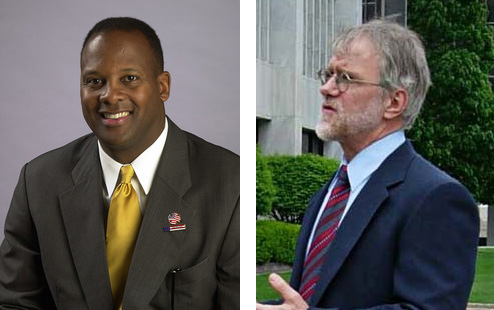
Otis Jennings, the Conservative Party candidate for mayor, and Howie Hawkins, the Green Party candidate for the District 4 common council seat, are third party candidates in Syracuse city elections.
When Kristi Andersen first ran for public office in her town of Cazenovia in 2005, she decided she needed an endorsement from a third party to solidify her candidacy.
So Andersen, a Syracuse University political science professor, simply created her own — the Strong Community Party. Her reason: To distinguish herself from the other Democrats in Cazenovia’s town board race.
“The thinking is that a Republican who just strictly won’t vote for a Democrat might vote for someone on another ticket,” Andersen said. “You get some leverage as a Democratic candidate with a third-party endorsement.”
Andersen is among the political figures who take advantage of New York’s unusual third-party rules. New York is one of only eight states to allow candidates to run on multiple party tickets. New York has five major third parties: Independence, Green, Conservative, Libertarian and Working Families.
Candidates like Andersen are tapping into one of the many roles New York’s third parties play. Like Andersen’s specially created party, third parties make candidates running with multiple nominations more attractive to dissenters in the two major parties, Democrats and Republicans. Third parties also provide a different, expanded message outside of the Democrats and Republicans, forcing those parties to think about certain issues differently. And they give voters with specialized interests a voice in the political process.
Many candidates benefit from third party endorsements that can prove crucial in primary and even general elections.
For example, in the Syracuse mayoral race, Otis Jennings lost the Republican primary on Sept. 15 to Steve Kimatian. But Jennings will still be on the ballot Nov. 3 on the Conservative Party line. And Stephanie Miner, the common councilor who won the Democratic primary, is also supported by the Working Families Party.
SU political science professor Jeff Stonecash, who specializes in American political parties, said a third-party endorsement could be critical for major party candidates looking to attract voters with specific interests.
“If you’re a Democrat in upstate New York, which is traditionally conservative,” Stonecash said, “a Conservative Party endorsement is huge.”
Third parties also bring in new voters and give voters who want specific issues addressed a voice in the political conversation, said Stonecash. “Third parties serve as an outlet for more specialized, focused interest and specific expression,” Stonecash said. “It gives people who have specific interests motivation to register to vote.”
The Working Families Party, for example, has pushed for living wage laws in Syracuse that pay some workers more than the minimum wage. The ordinance requires companies with five or more employees and at least $20,000 in business with the city to pay a living wage of at least $10.01 per hour.
And third parties, say some of their members and political experts, also expand public debate about a variety of issues that often don’t resonate within the two major parties.
Howie Hawkins, a UPS truck loader by day and third-party candidate by night, expresses pride in prodding the major parties to talk about issues such as alternative energy sources. Hawkins is a co-founder of the Green Party. The 2009 election will mark his 14th run for office on the Green Party ticket — this time for the District 4 Common Council seat. He’s challenging incumbent Democrat Tom Seals.
Hawkins portrays the expanded range of issues as a win for Greens. “We haven’t lost,” Hawkins said. “We’ve won by having influence on a lot of issues in American politics.”
As for candidates such as Andersen, the SU political science professor and Cazenovia town board member, third parties can deliver voters and victory. “In 2005, I was running as an ‘insurgent’ in a very Republican area,” Andersen said. “It was very important that we had another line.”
Andersen added: “If we hadn’t had that line, we would not have won with just the votes on the Democratic line.”
(Brett LoGiurato is a junior with dual majors in political science and newspaper journalism.)
-30-


